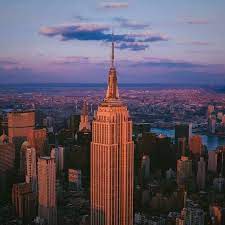
These famous and world-famous (and recognized) attract millions of visitors every year, but have you ever wondered what their history is? During the tour, you will probably be introduced to some lesser-known things by a local guide, but until you visit one of them, here is your chance to learn more about them!
Empire State Building (New York)
It was built by slightly more than 3,400 workers, who (be careful now) built four floors every week! Therefore, it is no wonder that the entire necklace was completed in only 450 days.
At a height of 381 meters, it held the title of the tallest building in the world until 1972. About 40 million dollars were spent on its construction, and today’s value is an incredible 637 million. The building even has its own postal code, and the top was intended as a place where zeppelins would be “parked”.

And yes, let’s also say that there is not 102, but 103 floors, but the last one is reserved exclusively for VIP guests, so any of us mortals will hardly ever visit it.
Eiffel Tower (Paris)
The symbol of Paris is also one of the most recognizable buildings in the world. The tower, made for the World Exhibition in Paris, was built for two whole years, and consists of a total of 18 thousand pieces of iron. After 20 years, it was supposed to be demolished, but the city authorities decided to keep it because of the antenna on top, which was important for the radio signal.

Today, Paris is unimaginable without the tower, and not only is it visited by millions every year, but it is also the workplace for more than 600 Parisians.
Taj Mahal (Agra)
It took 22 thousand people, a thousand elephants, 28 different types of stone and 17 years to build it. The Taj Mahal is famous for its symmetry, and depending on the time of day, it is always a different color.

Legend has it that Shah Jahan tore the fingers and hands of the workers who worked on this building so that they could never build anything as beautiful again. An esthete, but also a rather cruel man.
Trevi Fountain (Rome)
Hardly anyone is not familiar with the legend that says that throwing a coin over the left shoulder into the Trevi Fountain guarantees a return to the Eternal City.

The city authorities have nothing against the fact that tourists have “embraced” the legend, given that every day around 3000 euros are poured into the fountain. So, annually, that fountain brings a little more than a million euros. Not bad, right?
Caritas workers collect all that money every day and donate it to more than 200 countries.
Sagrada Familia (Barcelona)
Whoever visited the Catalan capital, could not remain indifferent to the appearance of the Holy Family. The church is the pinnacle of the work of the great architect Antoni Gaudí, and although construction began in 1882, it is interesting that it is still not fully completed.

The legendary Gaudí worked on it for about 40 years, until his death, and according to the latest information, the cathedral is expected to be completed in 2025. They were alive, then they saw.
Statue of Liberty (New York)
Perhaps the first monument that comes to mind when it comes to the USA is certainly this woman with a torch in New York Harbor. The Statue of Liberty was made in France and is a gift from France to the USA. The fact that it was disassembled into 350 parts and transported by ship on the way to America speaks volumes for how big it is.

The sculpture represents the Roman goddess of liberty, and the face is modeled after the face of the sculptor’s mother. And yes, if this statue was wearing “shoes”, it would need the number 7801!
Hermitage (St. Petersburg)
One of the largest and most beautiful museums in the world is located in the imperial city of Saint Petersburg. It has more than three million pieces in its collection, including works by Michelangelo, Leonardo, Rubens, Rembrandt, Van Gogh and Picasso. The following speaks volumes about the size – if a visitor were to spend only a minute at each exhibit, it would take him 11 years to visit the entire museum.

The museum is specific in that it also “employs” 60 cats in charge of guarding the museum premises from mice.
Leaning Tower of Pisa
One of the most visited attractions in the world in the 1990s was closed to the public because the tower simply leaned too far, and the safety of visitors was at risk.
Noticing this, the Italian authorities came up with a plan to restore and return the tower to the position it had in 1838. The project was created by the architect Mikele Jamoilkovski, the tower was saved, and the entire operation cost 25 million euros.

Since 2001, it has been reopened to the public, so social media has been flooded with images of people “pushing” the tower.

Leave a comment